|
Welsh Ancestry
The family is descended from Aleth, the
eleventh century king of Dyfed. In about 1300 the family
came to Dolobran, in the parish of Meifod, Montgomeryshire,
where they lived for nearly five hundred years. By 1542
family members had the surname Lloyd, because in that year,
family member David Lloyd is recorded as being a juror in
Montgomeryshire. David’s son, also called David, and his son
John, were poets.
John’s son Charles, born in 1613,
married Elizabeth Stanley from Knockin in the Welsh borders,
and had four children, Charles, born in 1637, John, born in
1638, Elizabeth, born in 1639, and Thomas, born in 1640.
Charles senior enlarged the family home
at Dolobran, but died comparatively young in 1657. John
Lloyd went into law, and became one of the Six Clerks of
Chancery. He was educated at Jesus College
Oxford, the University’s first Protestant college, along
with his brothers. Charles studied medicine, but left early
because he was unhappy with the persecution of Quakers, an
organisation with which he clearly sympathised. He married
Elizabeth, daughter of Sampson Lort, the Member of
Parliament for Pembroke.
The Quaker name comes from the phrase
“To tremble in the way of the Lord.” The movement began in
the 17th century, and formed The Society of Friends. In its
early years it suffered greatly from persecution, possibly
because it was seen as a radical movement, which promoted an
entirely new way of life, with a different lifestyle, and
different objectives. This was not helped by the fact that
Quakers had a different style of dress, and a different way
of speaking.
In 1662 Charles joined the Quakers, and
before the year was out found himself in prison in
Welshpool, along with seven other members of the society.
Edward Lord Herbert , Baron of Chirbury, ordered five of
them, including Charles, to visit his house at Llyssin for
an interview, and asked them to take the oath of allegiance
and supremacy. When they refused, because of their religious
beliefs, he sent them to prison in Welshpool.
George Fox, one of the founders, and
leader of the Quaker movement, visited them in prison, and
described the conditions, as follows:
They are kept very close together and placed in a dirty,
nasty place on the ground floor. Above them are the town’s
felons whose excrements and urine often fall upon them. They
have little more than wet straw to lie on.
Three of them died in the prison, and
the remaining five had to serve up to ten years before
release. Surprisingly, some of their wives joined them in
the squalid conditions, where several of their children were
born and raised. One of the wives was Elizabeth Lloyd, who
left her four months old son, Charles junior, to join her
husband in the terrible conditions. Charles and Elizabeth’s
possessions were seized, their cattle were sold, and their
house was partially destroyed.
In November 1662 the eight society
members sent a paper to the quarter sessions at Montgomery,
pleading for release from their horrifying ordeal, but to no
avail. Charles’ brother Thomas knew nothing of his
imprisonment until he returned home from Oxford. By this
time he had also become a Quaker. On discovering his
brother’s suffering, he went to see Richard Davies, a Quaker
who had a small estate at Welshpool. Together they visited
most of the Welsh justices including Edward Lord Herbert to
plead for the release of their fellow members. After
listening to their story, he agreed to allow the prisoners
to leave the prison, but they had to remain in Welshpool.
In 1663, on hearing the good news,
Charles and Elizabeth, and their children, took a house in
the town, but sadly Elizabeth died in 1665 whilst still
quite young. She was buried in the Friends' burial ground at
Cloddian Cochion, near Welshpool. In 1664 Thomas Lloyd also
became a prisoner in the same town. Charles and his children
stayed at the house until they were released in March 1672
under the terms of King Charles II’s Declaration of
Indulgence.

Charles Lloyd had two sons, Charles
junior, born in 1662, Sampson, born in 1664, and daughter
Elizabeth, also born in 1664. After their release they
returned to Dolobran, where Charles rebuilt and enlarged the
house, and built a Quaker meeting house where some years
later, George Fox, the famous Quaker, and one of the
founders of the Society of Friends, held a meeting. Both
Charles and Thomas were heavily involved in the movement and
visited many of the prominent Quakers of the day.
Thomas moved to Maesmawr, near
Welshpool, where he continued to suffer persecution and
fines. In 1683 he emigrated with his family to America, and
became President of the Provincial Council, and Deputy
Governor of Pennsylvania.
In 1686 Charles married his second
wife, Annie Lawrence, who had been one of his fellow
prisoners at Welshpool. In 1693 his daughter Elizabeth,
married John Pemberton from Birmingham, and moved to the
city, the Lloyd family’s first link with the West Midlands.
In 1698 Charles visited Elizabeth and
John at their home in Birmingham, and sadly died there. He
was buried at the old Friends' burial ground in Bull Lane,
off Monmouth Street, now Colmore Row, Birmingham. His second
wife Ann, who died in 1708, was also buried there, as where
the Pembertons. |